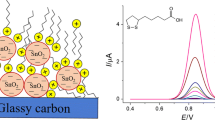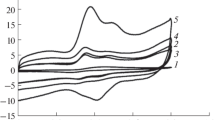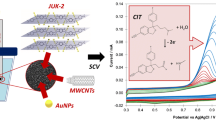Abstract
A sensitive electrochemical method was developed for the determination of doxorubicin at a glassy carbon electrode (GCE) modified with a nano-titania (nano-TiO2)/nafion composite film. Nano-TiO2 was dispersed into nafion to give a homogeneous suspension. After solvent evaporation, a uniform film of nano-TiO2/nafion composite was obtained on the GCE surface. The nano-TiO2/nafion composite film modified GCE exhibited excellent electrochemical behavior toward the reduction of doxorubicin. Compared to the reduction of doxorubicin at the bare GCE, the reduction current of doxorubicin at the nano-TiO2/nafion composite film modified GCE was greatly enhanced. Based on this, a novel voltammetric method was applied to the determination of doxorubicin. The experimental parameters that influence the reduction current of doxorubicin, were optimized. Under optimal conditions, a linear response of doxorubicin was obtained in the range from 5.0 × 10−9 to 2.0 × 10−6 mol L−1 (R = 0.998) and with a limit of detection (LOD) of 1.0 × 10−9 mol L−1(S/N = 3). The RSD of the measurement is 4.7%, and the RSD of the inter-electrode is of 5.1% which indicate the reproducibility of this method. The current response decreased only by around 3.8% of its initial response after 2 weeks exposing the electrode in air. The procedure was applied to assay doxorubicin in human plasma samples with the recoveries of 94.9–104.4%.






Similar content being viewed by others
References
Buzdar AU, Marcus C, Smith TL, Blumenschein GR (1985) Early and delayed clinical cardiotoxicity of doxorubicin. Cancer 55:2761
Bruijn de P, Verweij J, Loos WJ, Kolker HJ, Planting AST, Nooter K, Stoter G, Sparreboom A (1999) Determination of doxorubicin and doxorubicinol in plasma of cancer patients by high-performance liquid chromatography. Anal Biochem 266:216
Badea I, Lazar L, Moja D, Nicolescu D, Tudose A (2005) A HPLC method for the simultaneous determination of seven anthracyclines. J Pharm Biomed Anal 39:305
Jacobi U, Waibler E, Bartoll J, Schulze P, Sterry W, Lademann J (2004) Quantification of doxorubicin and metabolites in rat plasma and small volume tissue samples by liquid chromatography/electrospray tandem mass spectroscopy. J Chromatogr B 808:141
Yang YH (2007) Development and validation of a high-performance liquid chromatography tandem mass spectrometric method for quantification of daunorubicin in rat plasma. Talanta 71:596–604
Zagotto G, Gatto B, Moro S, Sisi C, Palumbo M (2001) Anthracyclines: recent developments in their separation and quantitation. J Chromatogr B 764:161–171
Gavenda A, Sevcik J, Psotova J, Bednar P, Bartak P, Adamovsky P, Simanek V (2001) Determination of anthracycline antibiotics doxorubicin and daunorubicin by capillary electrophoresis with UV absorption detection. Electrophoresis 22:2782–2785
Chen Y, Walsh RJ, Arriaga EA (2005) Selective determination of the doxorubicin content of individual acidic organelles in impure cubcellular fractions. Anal Chem 77:2281
Sastry CSP, Rao J (1996) Determination of doxorubicin hydrochloride by visible spectrophotometry. Talanta 43:1827
Loren A, Eliasson C, Josefson M, Murty KVGK, Käll M, Abrahamsson J, Abrahamsson K (2001). J Raman Spectrosc 32:971
Trevisan MG, Poppi RJ (2003) Determination of doxorubicin in human plasma by excitation-emission matrix fluorescence and multi-way analysis. Anal Chim Acta 493:69
Hu JB, Li QL (1999) Voltammetric behavior of adriamycin and its determination at Ni ion-implanted electrode. Anal Sci 15:1215
Zhang SH, Wu KB, Hu SS (2002) Carbon paste electrode based on surface activation for trace adriamycin determination by a preconcentration and voltammetric method. Anal Sci 18:1089
O’Regan B, Gratzel M (1991) A low-cost,high-efficiency solar cell based on dye-sensitized colloidal TiO2 films. Nature 353:737–740
Eychmqller A (2000) Structure and photophysics of semiconductor nanocrystals. J Phys Chem B 104:6514–6528
Clifford JN, Palomares E, Nazeeruddin MK, Thampi R, Gratzel M (2004) Multistep electron transfer processes on dye co-sensitized nanocrystalline TiO2 Films. J Am Chem Soc 126:5670
Iuchi K, Ohko Y, Tatsuma T, Fujishima A (2004) Cathode-separated TiO2 photocatalysts applicable to a photochromic device responsive to backside illumination. Chem Mater 16:1165–1167
Topoglidis E, Cass AEG, Gilardi G, Sadeghi S, Beaumont N, Durrant JR (1998) Protein adsorption on nanocrystalline TiO2 films: an immobilization strategy for bioanalytical devices. Anal Chem 70:111
Diebold U (2003) The surface science of titanium dioxide. Surf Sci Rep 48:53
Topoglidis E, Lutz T, Willis RL, Barnett CJ, Cass AEG, Durrant JR (2000) Protein adsorption on nanoporous TiO2 films: a novel approach to studying photoinduced protein/electrode transfer reactions. Faraday Discuss 116:35
Choi HN, Kim MA, Lee WY (2005) Amperometric glucose biosensor based on sol-gel-derived metal oxide/Nafion composite films. Anal Chim Acta 537:179
Yuan S, Hu SS (2004) Characterization and electrochemical studies of Nafion nano-TiO2 film modified electrodes. Electrochim Acta 49:4287
Acknowledgement
This work was supported by the Key Project of Chinese Ministry of Education (No. 206104), the Open Project Program of Key Laboratory of Low Dimensional Materials and Application Technology (Xiangtan University), Ministry of Education, China (No. KF0501) and the Multidiscipline Scientific Research Foundation of Xiangtan University (No. 05IND08).
Author information
Authors and Affiliations
Corresponding authors
Electronic supplementary material
Below is the link to the electronic supplementary material.
Rights and permissions
About this article
Cite this article
Fei, J., Wen, X., Zhang, Y. et al. Voltammetric determination of trace doxorubicin at a nano-titania/nafion composite film modified electrode in the presence of cetyltrimethylammonium bromide. Microchim Acta 164, 85–91 (2009). https://doi.org/10.1007/s00604-008-0037-y
Received:
Accepted:
Published:
Issue Date:
DOI: https://doi.org/10.1007/s00604-008-0037-y




